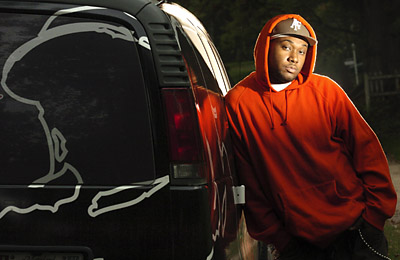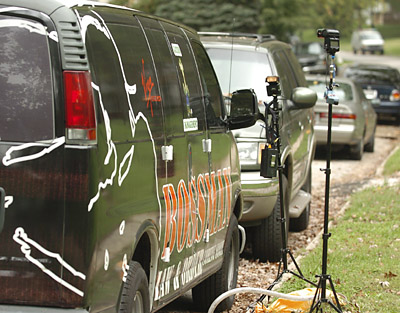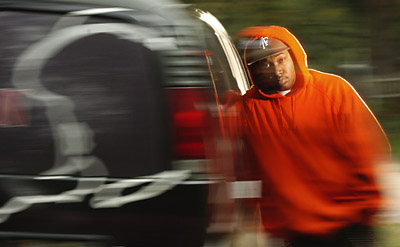 On some photos, you take satisfaction not so much from the photo itself but from the process that got you to it. Such was the case a couple of weeks ago, when I was assigned to shoot an up-and-coming rap artist in Baltimore.
On some photos, you take satisfaction not so much from the photo itself but from the process that got you to it. Such was the case a couple of weeks ago, when I was assigned to shoot an up-and-coming rap artist in Baltimore. I arrive at his house a couple of minutes early for the assignment as he is finishing up the interview with the reporter. He tells me he is very tight for time, and offers to e-mail the paper a handout photo in lieu of the assigned photo.
Well, my editors are not exactly gonna like that, I think. So my first thought is to come up with an idea that I can pull off quickly.
To make matters worse, after talking for a few minutes with the guy I get the feeling he is just not really into being photographed on this particular day.
Alrighty, then. Time for Plan B.
At this point, you have to recognize a decaying situation for what it is and circle the wagons a little. You have to remind your subject how, with just a little time, you can work together to make something that looks cool and unique. I tell him I brought lights - I always have lights - and have a good idea for a photo in his home studio.
This much is true. I always try to preconceive a photo if for no other reason than to have a foundation on which to improvise.
Turns out he is not interested in having a shot done in the home studio. So I backpedal a little more and find out what he might be interested in doing.
Mind you, all of this is happening in real-time, over the span of about 30 seconds. I don't want to lose this guy. But I do not want to come back with a lame photo, either.
Parked outside the rapper's house is a conversion van on which he has painted with his logo and the logo of Virgin Records, who has recently signed him to a recording contract.
The van is not my first choice for a photo. Or my second or third, for that matter. But it is clear that it is somewhat of a point of pride for the guy. So I do not resist when he repeatedly steers the conversation to it as a possible backdrop.
(Hey, at least we are talking about actually shooting a photo at this point.)
So I tell him to go ahead and get ready to leave, and to meet me outside at his van in five minutes for about a two-minute shoot.
Now all I have to do is to come up with an idea (and a way to light it, and to set up the lights) in 5 minutes.
No prob.
First step is to put your lights, stands and syncs together in one fell swoop. While you are doing this, you assess the scene and try to visualize a finished photo.
The van is black, so I decide to go with a dark key for the photo. Luckily, it's cloudy, which gives me more light ratio options on the small flashes. Thank goodness for that, at least.
I quickly decide on something overly-lit and a little theatrical. I am going to shoot him leaning against the van and light him from two directions.
The strongest light - and the one that will determine the look of the photo - will be a direct backlight. I decide to use direct flash, (a Nikon SB-800) on full power, with a CTO gel for color separation.
So, I set that light up and pop a test shot at 1/250th (max sync speed) to see where me ambient ends up with the very small aperture (f/16, I think) that the full-power flash gave me.
Remember, the flash is aiming back at me, so I shield the light with my hand for the test shot. The ambient goes to darn-near black while the light rims my hand and lights the van at the same time. Great. I have all of the lighting control that I need.
Now to light the front of him.
With my working aperture at f/16, I bring another manual flash (a Nikon SB-24) in from upper camera right. This one is set to 1/4 power, which is what it took to light my hand to the correct exposure using the already established exposure of f/16 @ 1/250th. Again, a couple of test pop verified it. After a while, you get pretty close on the first try, then you fine-tune it with a shot or two.
I set the flash zoom setting on 105mm, to control the beam spread of the light. Now, by aiming the flash a little high, I can get a nice falloff on the bottom of the guy and seal off the photo a little with the darkened bottom.
Here's the setup:

And here he comes, right on cue, walkin' fast and lookin' late.
But I have him all ready to go. One quick test confirms that my exposure is on target. (If it wasn't, a quick adjust and another test shot, and I'd be in business.)
I then shoot about 20 frames, so I am covered if the guy really has to bolt. But I want to get a little more time out of him to try two or three variation.
Here's one of my favorite tricks for squeezing a little more time out of a subject.
Up until now, my demeanor has been one of efficient professionalism: Shoot quick. "Look this way." Got it, thank you. "Chin up a little." Thank you. Etc.
To try for the extra time, I stop and make a point of taking a look at the back of the camera.
Now, all of the sudden, I am "surprised" by how well this is turning out. (Not really - I knew exactly what I was gonna get. But he didn't.)
"Cool! Check this out - this looks great!" I tell him.
Of course, he'll wanna look. It's a photo of him. Yeah, it does look good, he agrees.
(I mean, how could it not, with such fine raw material to work with, right?)
And, in an instant, here's the deal as it now exists:
If he loves it, he'll almost certainly find a few more minutes to keep shooting. Why short-change the viewing public, after all?
If he hates it, he'll show you with his expression. Even if he lies and says it's okay. Just ask him what is bothering him, and introduce a variation to fix it with a few more minutes' shooting time.
He's not editing you - you already have what you were gonna get in the can. But you are bringing him into the portrait process in exchange for what is almost certainly going to yield more shooting time.
I have had five-minute corporate CEO shoots turn into 30-minute sessions this way.
They all want to look good.

In this case, I got a few extra minutes to play with different shutter speeds and try some flash-drag-camera-jerk stuff.
I preferred the original setup, and we went with that.
But the important point is that I went from "sorry, no photos today please," to multiple shooting setups, lit for effect and quickly produced - with variations on the visual theme as a bonus.
It's not enough to know how to light. You need to have a selection of techniques that you already know, and can go to quickly. And that includes setup time.
But beyond that, you need to cultivate the interpersonal skills to bring someone along (while you quietly panic on the inside) and work to make something out of nothing.
Always remember that for most people, the thought of being photographed - especially for publication - is a bit of a head rush. Sometimes you have to use that, and appeal to the person's ego, to overcome the natural shyness and self-consciousness that we all have to some degree.
And if you can do it quickly and smoothly, that's just bonus points for you.
Next: Zebra Fish and Zygotes




0 comments:
Post a Comment